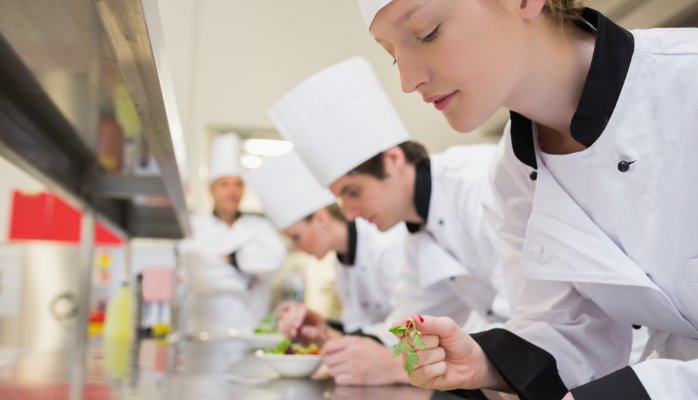
Why do chefs wear white? And other answers.
When you’re out at a restaurant, it’s pretty easy to spot the chef. In white jackets, their hats tower above the diners enjoying what they’ve worked so hard to prepare.
We see a lot of chef coats here at SITEX, and work hard to make sure they stay as clean as the day they were new. Cooking is a messy profession, and since we remove stains from so many coats, we were curious to why they were white to begin with. Here’s what we found.
A classic chef outfit has a white double-breasted jacket with knotted cloth buttons, the toque blanche (white chef hat), and either checkered or black pants. The hat and jacket are said to derive from historical traditions, while the pants are purely practical. Checked or dark pants are far better at hiding stains and spills than lighter colored solid pants.
The toque blanche (the French translation is literally “white hat”) is believed to most likely be an evolution of earlier head coverings worn by chefs dating back to the 1500s. The hats were originally worn to designate rank, with the height of the toque representing the chef’s tenure.. Later the use of head coverings was deemed necessary for chefs and other kitchen staff for sanitary reasons, and the toque is still widely in use. Today in certain kitchens, the height of the toque still represents rank. The head chef will have the tallest hat, and younger cooks will often wear hats more resembling caps. There are 100 folds in a traditional hat, which is said to represent the number of ways a chef knows how to cook an egg.
Chefs are said to have started wearing white while working in monasteries. During this period (1500s), chefs and monks would wear the same clothing. Everyone would dress in long robes and tall hats, but the monks would be dressed in black. Chefs dressed in gray to differentiate themselves. Today, white is associated with cleanliness, which is essential when preparing food. Chefs continue wearing the traditional white as a sign of professionalism and the high regard they have for their profession.
Similar to the darker-colored pants, the other noticeable quirks of chef’s clothing comes from practicality. Chef jackets are made of thick cotton that is double layered to protect the chef against heat and accidental splashes of hot liquid. These jackets are also usually double-breasted, so if the chef should get something on his or her jacket, they can simply reverse it. Buttons on jackets are usually made of knotted cloth so they will be able to withstand the heat of the kitchen and frequent washes, where plastic buttons would melt, and other material may break.
While traditional, this is by no means the only way to dress while in the kitchen. In more recent years, chefs have been moving towards setting their own kitchen standards, dressing in more fun, non-traditional clothes, sometimes eschewing the white coat altogether in favor of a simple apron. The uniform that chefs choose is often a matter of personal style, but if you choose to keep the tradition alive with a white coat, you’re in good company.
SITEX wants to help you maintain the most professional image you can in any job, and we offer a full selection of aprons, chef jackets and other kitchen linens for you to choose from, no matter your style. View our catalog today to find your perfect toque, and take pride in the fact that you’re following in the footsteps of culinary professionals.